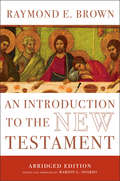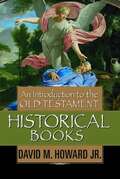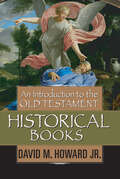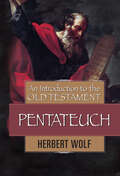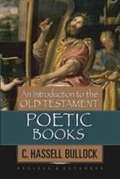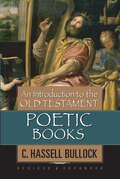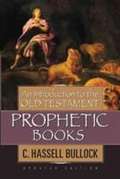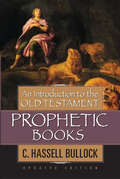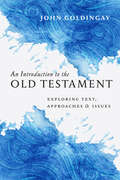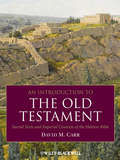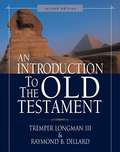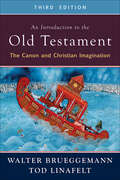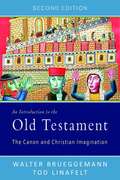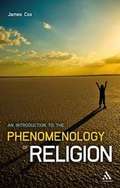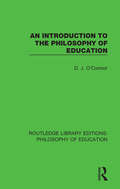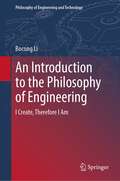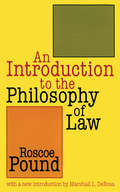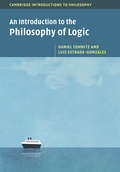- Table View
- List View
An Introduction to the New Testament: History, Literature, Theology
by M. Eugene BoringThis thoroughly researched textbook from well-respected scholar M. Eugene Boring presents a user-friendly introduction to the New Testament books. Boring approaches the New Testament as a historical document, one that requires using a hands-on, critical method. Moreover, he asserts that the New Testament is the church's book, in that it was written, selected, preserved, and transmitted by the church. Boring goes on to explore the historical foundation and formation of the New Testament within the context of pre-Christian Judaism and the world of Jesus and the early church. He then examines the individual books of the New Testament, providing helpful background information and methods for interpretation, and revealing the narrative substructure found within each of the Gospels and Letters. This volume includes helpful illustrations, charts, notes, and suggestions for further reading. Sections are laid out in a well-organized manner to help students navigate the content more easily.
An Introduction to the New Testament: The Abridged Edition
by Raymond E. Brown Marion SoardsSince its publication in 1997, Raymond Brown's Introduction to the New Testament has been widely embraced by modern readers seeking to understand the Christian Bible. Acknowledged as a paragon of New Testament studies in his lifetime, Brown was a gifted communicator who wrote with ease and clarity.  Abridged by Marion Soards, who worked with Brown on the original text, this new, concise version maintains the essence and centrist interpretation of the original without tampering with Brown's perspective, insights, or conclusions. The biblical writings themselves remain the focus, but there are also chapters dealing with the nature, origin, and interpretation of the New Testament texts, as well as chapters concerning the political, social, religious, and philosophical world of antiquity. Furthermore, augmenting Brown's commentary on the New Testament itself are topics such as the Gospels' relationship to one another; the form and function of ancient letters; Paul's thought and life, along with his motivation, legacy, and theology; a reflection on the historical Jesus; and a survey of relevant Jewish and Christian writings.  This comprehensive, reliable, and authoritative guidebook is now more accessible for novices, general readers, Bible study groups, ministers, scholars, and students alike.
An Introduction to the Old Testament Historical Books
by David M. HowardRich rewards await readers who dig deep into the historical books of the Old Testament. Incredible events, amazing love stories, larger-than-life personalities, and deep theological themes are just some of the treasures found in Joshua, Judges, Ruth, 1 and 2 Samuel, 1 and 2 Kings, 1 and 2 Chronicles, Ezra, Nehemiah, Esther. <p><p> These books tell the story of the nation of Israel and the God who loves her, punishes her, and always brings this recalcitrant people back to Himself. It is really the story of all of us. <p><p> David M. Howard Jr. provides an in-depth introduction to the Old Testament historical books, focusing first on the overarching themes of historical narrative in general. He then turns his attention to each book, considering topics like: <p>• Authorship and date <p>• Place in the canon <p>• Historical and cultural context <p>• Theology of the book <p>• Special issues pertaining to the book <p><p> From the conquest of Canaan to the fall of Jerusalem, from war to peace and back to war, from kings and queens to farmers and housewives—David Howard covers it all in this invaluable introduction to the Old Testament historical books.
An Introduction to the Old Testament Historical Books
by David M. Howard Jr.Rich rewards await readers who dig deep into the historical books of the Old Testament. Incredible events, amazing love stories, larger-than-life personalities and deep theological implications and themes are just part of the t treasure that awaits readers of Joshua, Judges, Ruth, 1 & 2 Samuel, 1 & 2 Kings, 1 & 2 Chronicles, Ezra, Nehemiah, Esther.These books tell the story of the nation of Israel and the God who loves her, punishes her, and always brings this recalcitrant people back to Himself. It is really the story of all of us.David M. Howard Jr. provides an in-depth introduction to the Old Testament historical books, focusing first on the overarching themes of historical narrative in general. He then turns his attention to each book.From the conquest of Canaan to the fall of Jerusalem, from war to peace and back to war, from kings and queens to farmers and housewives--David Howard covers it all in this invaluable introduction to the Old Testament historical books.
An Introduction to the Old Testament Historical Books
by David M. Howard Jr.Rich rewards await readers who dig deep into the historical books of the Old Testament. Incredible events, amazing love stories, larger-than-life personalities and deep theological implications and themes are just part of the t treasure that awaits readers of Joshua, Judges, Ruth, 1 & 2 Samuel, 1 & 2 Kings, 1 & 2 Chronicles, Ezra, Nehemiah, Esther.These books tell the story of the nation of Israel and the God who loves her, punishes her, and always brings this recalcitrant people back to Himself. It is really the story of all of us.David M. Howard Jr. provides an in-depth introduction to the Old Testament historical books, focusing first on the overarching themes of historical narrative in general. He then turns his attention to each book.From the conquest of Canaan to the fall of Jerusalem, from war to peace and back to war, from kings and queens to farmers and housewives--David Howard covers it all in this invaluable introduction to the Old Testament historical books.
An Introduction to the Old Testament Pentateuch
by Herbert WolfThe Pentateuch--Genesis, Exodus, Leviticus, Numbers, Deuteronomy--are the vital first books in the Bible. understanding the scope, meaning, and events of these five books is integral to understanding the whole of Scripture that follows.Old Testament expert Herbert Wolf provides layreaders and scholars alike with a strong undergirding of understanding and knowledge in this introduction that reveals both the seriousness and excitement of the Pentateuch. Readers will find Adam, Abraham, Joseph, Moses and Joshua in these pages, as well as terrible sin and glorious forgiveness, bloody sacrifices and battles, deadly betrayal and life-giving hope.Wolf first addresses the overarching themes that flow through the Pentateuch, with special attention given to Moses as author of the five books. He then addresses each book specifically, covering topics such as purpose and scope, and literary structure. He tailors additional study to each specific book. This book contributes significantly to a clear, deep understanding of the Bible's first five books.
An Introduction to the Old Testament Pentateuch
by Herbert WolfThe Pentateuch--Genesis, Exodus, Leviticus, Numbers, Deuteronomy--are the vital first books in the Bible. understanding the scope, meaning, and events of these five books is integral to understanding the whole of Scripture that follows.Old Testament expert Herbert Wolf provides layreaders and scholars alike with a strong undergirding of understanding and knowledge in this introduction that reveals both the seriousness and excitement of the Pentateuch. Readers will find Adam, Abraham, Joseph, Moses and Joshua in these pages, as well as terrible sin and glorious forgiveness, bloody sacrifices and battles, deadly betrayal and life-giving hope.Wolf first addresses the overarching themes that flow through the Pentateuch, with special attention given to Moses as author of the five books. He then addresses each book specifically, covering topics such as purpose and scope, and literary structure. He tailors additional study to each specific book. This book contributes significantly to a clear, deep understanding of the Bible's first five books.
An Introduction to the Old Testament Poetic Books
by C. Hassell BullockThe poetic books of the Old Testament--Job, Psalms, Proverbs, Ecclesiastes, and the Song of Solomon--are often called humankind's reach toward God. The other books of the Old Testament picture God's reach toward man through the redemptive story. Yet these five books reveal the very heart of men and women struggling with monumental issues such as suffering, sin, forgiveness, joy, worship, and the passionate love between a man and woman.
An Introduction to the Old Testament Poetic Books
by C. Hassell BullockThe poetic books of the Old Testament--Job, Psalms, Proverbs, Ecclesiastes, Song of Solomon--are often called humankind's reach toward God. The other books of the Old Testament picture God's reach toward man through the redemptive story. Yet these five books reveal the very hear of men and women struggling with monumental issues such as suffering, sin, forgiveness, joy, worship, and the passionate love between a man and woman.C. Hassell Bullock, a noted Old Testament scholar, delves deep into the hearts of the five poetic books, offering readers helpful details such as harmeneutical considerations for each book, theological content and themes, detailed analysis of each book, and cultural perspectives.Hebrew is a language of "intrinsic musical quality that naturally supports poetic expression," says Bullock in his introduction. That poetic expression comes from the heart of the Old Testament writers and reaches all of us exactly where we are in our own struggles and joys.
An Introduction to the Old Testament Poetic Books
by C. Hassell BullockThe poetic books of the Old Testament--Job, Psalms, Proverbs, Ecclesiastes, Song of Solomon--are often called humankind's reach toward God. The other books of the Old Testament picture God's reach toward man through the redemptive story. Yet these five books reveal the very hear of men and women struggling with monumental issues such as suffering, sin, forgiveness, joy, worship, and the passionate love between a man and woman.C. Hassell Bullock, a noted Old Testament scholar, delves deep into the hearts of the five poetic books, offering readers helpful details such as harmeneutical considerations for each book, theological content and themes, detailed analysis of each book, and cultural perspectives.Hebrew is a language of "intrinsic musical quality that naturally supports poetic expression," says Bullock in his introduction. That poetic expression comes from the heart of the Old Testament writers and reaches all of us exactly where we are in our own struggles and joys.
An Introduction to the Old Testament Prophetic Books
by C. Hassell BullockThe Old Testament prophets spoke to Israel in times of historical and moral crisis. They saw themselves as being a part of a story that God was weaving throughout history--a story of repentance, encouragement, and a coming Messiah. In this updated introductory book, each major and minor prophet and his writing are clustered with the major historical events of their time. Our generational distance from the age of the prophets might seem to be a measureless chasm. Yet we dare not make the mistake of assuming that passing years have rendered irrelevant not only the Old Testament prophets, but also the God who comprehends, spans, and transcends all time. In these pages, C. Hassell Bullock presents a clear picture of some of history's most profound spokesmen--the Old Testament prophets--and the God who shaped them.
An Introduction to the Old Testament Prophetic Books
by C. Hassell BullockThe Old Testament prophets spoke to Israel in times of historical and moral crisis. They saw themselves as being a part of a story that God was weaving throughout history--a story of repentance, encouragement, and a coming Messiah. In this updated introductory book, each major and minor prophet and his writing are clustered with the major historical events of their time. Our generational distance from the age of the prophets might seem to be a measureless chasm. Yet we dare not make the mistake of assuming that passing years have rendered irrelevant not only the Old Testament prophets, but also the God who comprehends, spans, and transcends all time. In these pages, C. Hassell Bullock presents a clear picture of some of history's most profound spokesmen--the Old Testament prophets--and the God who shaped them.
An Introduction to the Old Testament Prophetic Books
by C. Hassell BullockThe Old Testament prophets spoke to Israel in times of historical and moral crisis. They saw themselves as being a part of a story that God was weaving throughout history--a story of repentance, encouragement, and a coming Messiah. In this updated introductory book, each major and minor prophet and his writing are clustered with the major historical events of their time. Our generational distance from the age of the prophets might seem to be a measureless chasm. Yet we dare not make the mistake of assuming that passing years have rendered irrelevant not only the Old Testament prophets, but also the God who comprehends, spans, and transcends all time. In these pages, C. Hassell Bullock presents a clear picture of some of history's most profound spokesmen--the Old Testament prophets--and the God who shaped them.
An Introduction to the Old Testament: Exploring Text, Approaches & Issues
by John GoldingayEnter the classroom of one of today?s premier biblical interpreters as he shares his infectious love for the Old Testament. This is where you begin the adventure of exploring the Bible?s First Testament. Some Old Testament introductions tell you what you could have seen for yourself. They might recount in detail what other scholars have said, and then tell you what you should think about it. But with refreshing directness, John Goldingay outfits you with basic knowledge, points out the main approaches, outlines the primary issues and then sets you loose to explore the terrain for yourself. Traverse the grand tapestry of the Torah. Discern the art and grain of biblical narrative. Listen to the cries, confessions and cadences of the Psalms. Probe the varied textures of wisdom literature. And ponder the prophets in the darkening nightmare of exile and the distant light of hope. More workbook than handbook, this introduction to the Old Testament is rooted in decades of tried and proven teaching. Goldingay displays a robust confidence in the truthfulness of Scripture combined with a refreshing trust in the reader's ability to grapple responsibly with the Old Testament. Even when the text hits you sideways, Goldingay encourages you not to squirm or run, but to grab hold and go deeper. Under his expert guidance the cordon between faith and criticism swings open into theological and spiritual insight.
An Introduction to the Old Testament: Sacred Texts and Imperial Contexts of the Hebrew Bible (Journal For The Study Of The Old Testament Supplement #No. 225.)
by David M. CarrThis comprehensive, introductory textbook is unique in exploring the emergence of the Hebrew Bible in the broader context of world history. It particularly focuses on the influence of pre-Roman empires, empowering students with a richer understanding of Old Testament historiography. Provides a historical context for students learning about the development and changing interpretations of biblical texts Examines how these early stories were variously shaped by interaction with the Mesopotamian and Egyptian, Assyrian, Babylonian, Persian, and Hellenistic empires Incorporates recent research on the formation of the Pentateuch Reveals how key biblical texts came to be interpreted by Jewish, Christian, and Muslim faiths Includes numerous student-friendly features, such as study questions, review sections, bibliographies, timelines, and illustrations and photos
An Introduction to the Old Testament: Second Edition
by Tremper Longman IIIAn upper-level introduction to the Old Testament that offers students a thorough understanding of three key issues: historical background, literary analysis, and theological message.This second edition of An Introduction to the Old Testament integrates recent developments in Old Testament scholarship. It has many distinctive features that set it apart from other introductions to the Old Testament:It's committed to a theologically evangelical perspective.Emphasizes "special introduction"—the study of individual books.Interacts in an irenic spirit with the historical-critical method.Features points of research history and representative scholars rather than an exhaustive treatment of past scholarship.Deals with the meaning of each book, not in isolation but in a canonical context.Probes the meaning of each book in the setting of its culture.Including callouts, charts, and graphs, An Introduction to the Old Testament is written with an eye to understanding the nature of Old Testament historiography.Perfect for seminary students, professors, and Bible teachers and ministry leaders, as well as anyone looking for an in-depth and balanced approach to Old Testament study.
An Introduction to the Old Testament: The Canon and Christian Imagination
by Walter Brueggemann and Tod LinafeltAn Introduction to the Old Testament: The Canon and Christian Imagination (Second Edition)
by Walter Brueggemann Tod LinafeltIn this updated edition of the popular textbook, Walter Brueggemann and Tod Linafelt introduce the reader to the broad theological scope of the Old Testament, treating some of the most important issues and methods in contemporary biblical interpretation. This clearly written textbook focuses on the literature of the Old Testament as it grew out of religious, political, and ideological contexts over many centuries in Israel's history. Covering every book in the Old Testament (arranged in canonical order), the authors demonstrate the development of theological concepts in biblical writings from the Torah through post-exilic Judaism. This introduction invites readers to engage in the construction of meaning as they venture into these timeless texts.
An Introduction to the Phenomenology of Religion
by James L. CoxIn this revised edition, the author provides an easily accessible introduction to the phenomenology of religion, which he contends continues as a foundational method for the academic study of religion in the twenty-first century. After dealing with the problematic issue of defining religion, he describes the historical background to phenomenology by tracing its roots to developments in philosophy and the social sciences in the early twentieth century. The phenomenological method is then outlined as a step-by-step process, which includes a survey of the important classifications of religious behavior. The author concludes with a discussion of the place of the phenomenology of religion in the current academic climate and argues that it can be aligned with the growing scholarly interest in the cognitive science of religion.
An Introduction to the Philosophy of Art
by Richard EldridgeRichard Eldridge's compact survey of philosophical theories of the nature and significance of art draws on materials from classical and contemporary philosophy as well as literary theory and art criticism. Eldridge explores the representational, expressive, and formal dimensions of art, and argues that works of art present their subject matter as creations of enduring cognitive, moral, and social interest. His accessible study will be of interest to students and anyone interested in the relationship between thought and art.
An Introduction to the Philosophy of Education (Routledge Library Editions: Philosophy of Education #14)
by D. J. O'ConnorEducation, like every other important branch of knowledge, has its underlying philosophical problems. It is these problems and the attempts to solve them which together make up the philosophy of education. This book, first published in 1957, provides a simple explanation and illustration of what philosophy can (and cannot) do for educational thinking. This title will be of interest to students of the philosophy of education.
An Introduction to the Philosophy of Engineering: I Create, Therefore I Am (Philosophy of Engineering and Technology #39)
by Bocong LiThis book is the first academic work on the philosophy of engineering in China that reflects two decades of research. It puts forward a new thesis, namely that the core maxim in the philosophy of engineering is “I create, therefore I am,” which is radically different from the Cartesian maxim: “I think, therefore I am.” In addition, the book offers the first detailed portrait of the roots and evolution of the philosophy of engineering in China. The book begins by discussing the triptych thesis of science, technology and engineering, which argues that there are a number of important distinctions between the three, e.g. scientific activities are chiefly based on discovery, while technological activities center on invention, and engineering activities focus on creation. Considering the latest developments in the philosophy of engineering, the author also analyzes engineering communities, engineering practice and a micro–meso–macro framework. In subsequent chapters, the author separately analyzes the three stages of engineering activities: planning, operating and using artifacts. In the closing chapter, two views on the philosophy of engineering (as a new subdiscipline of philosophy and as a philosophy in its own right) are briefly explained.
An Introduction to the Philosophy of Language
by Michael MorrisIn this textbook, Michael Morris offers a critical introduction to the central issues of the philosophy of language. Each chapter focusses on one or two texts which have had a seminal influence on work in the subject, and uses these as a way of approaching both the central topics and the various traditions of dealing with them. Texts include classic writings by Frege, Russell, Kripke, Quine, Davidson, Austin, Grice and Wittgenstein. Theoretical jargon is kept to a minimum and is fully explained whenever it is introduced. The range of topics covered includes sense and reference, definite descriptions, proper names, natural-kind terms, de re and de dicto necessity, propositional attitudes, truth-theoretical approaches to meaning, radical interpretation, indeterminacy of translation, speech acts, intentional theories of meaning, and scepticism about meaning. The book will be invaluable to students and to all readers who are interested in the nature of linguistic meaning.
An Introduction to the Philosophy of Law (Storrs Lecture)
by Roscoe Pound Marshall. L DeRosaIn An Introduction to the Philosophy of Law, Roscoe Pound shows how philosophy has been a powerful instrument throughout the history of law. He examines what philosophy has done for some of the chief problems of the science of law and how it is possible to look at those problems philosophically without treating them in terms of a particular time period. The function of legal philosophy, writes Pound, is to rationally formulate a general theory of law which conforms to the interests, the general security first and foremost, of society. Marshall DeRosa writes in his new introduction that in the light of twentieth-century judicial politics, Roscoe Pound's philosophy of law has prevailed to a significant extent. This book's relevance to appreciating the development of the American legal system in all its complexities - including liability law, contract law, and property law - is in itself notable. But, in terms of understanding the twentieth-century development of the American rule of law, An Introduction to the Philosophy of Law is indispensable. It will make an invaluable addition to the personal libraries of legal theorists, philosophers, political scientists, and historians of American law.
An Introduction to the Philosophy of Logic (Cambridge Introductions to Philosophy)
by Daniel Cohnitz Luis Estrada-GonzálezPhilosophy of logic is a fundamental part of philosophical study, and one which is increasingly recognized as being immensely important in relation to many issues in metaphysics, metametaphysics, epistemology, philosophy of mathematics, and philosophy of language. This textbook provides a comprehensive and accessible introduction to topics including the objectivity of logical inference rules and its relevance in discussions of epistemological relativism, the revived interest in logical pluralism, the question of logic's metaphysical neutrality, and the demarcation between logic and mathematics. Chapters in the book cover the state of the art in contemporary philosophy of logic, and allow students to understand the philosophical relevance of these debates without having to contend with complex technical arguments. This will be a major new resource for students working on logic, as well as for readers seeking a better understanding of philosophy of logic in its wider context.

